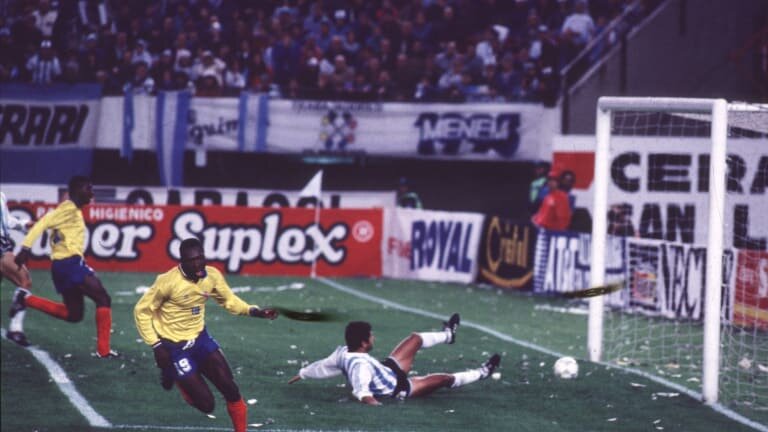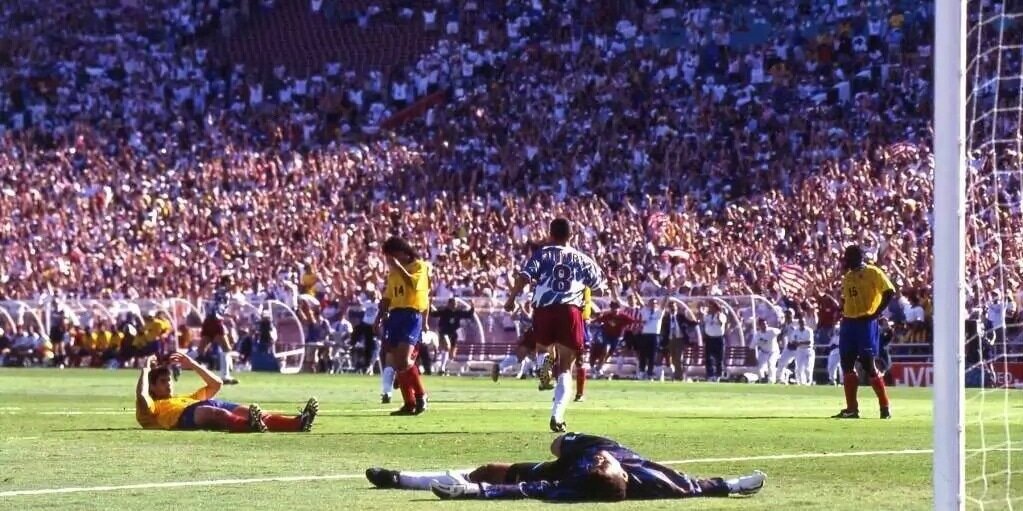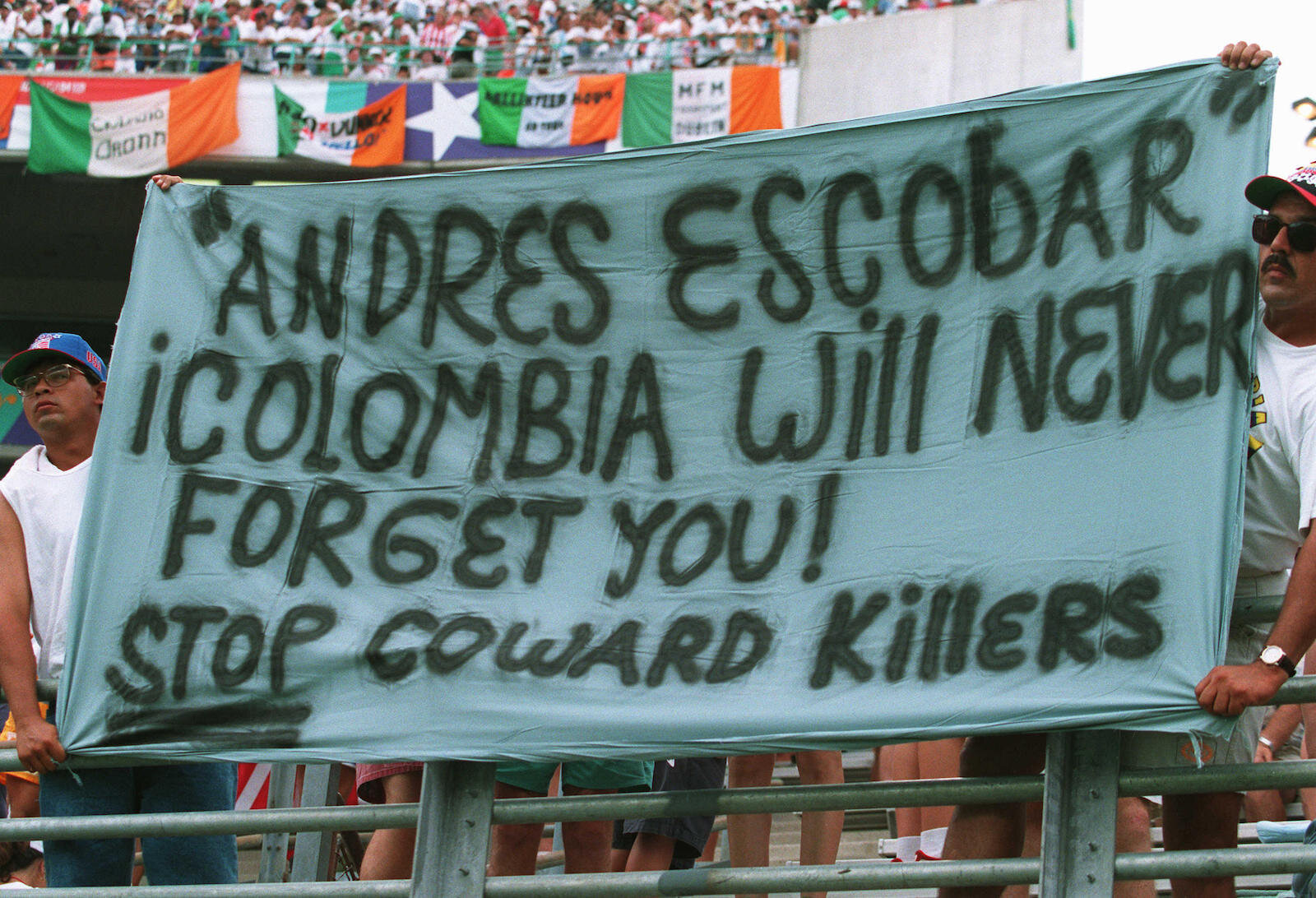Narco-Football | The Murder of Andrés Escobar
Colombia as a nation is probably most famous for two things; football and cocaine. The country’s production of cocaine gave birth to some of the most infamous drug cartels on earth, along with some of the richest and most well-known names in history, such as Pablo Escobar. While on the football pitch they have produced household names; James Rodríguez, Carlos Valderrama, Radamel Falcao and have given fans memorable footballing moments like goalkeeper René Higuita’s scorpion kick versus England at Wembley in 1995.
Narco Football
What a lot of people might not know is that the two, football and cocaine, were linked very closely and for a time Colombia’s on-the-field success was so blatantly linked to the country’s drug cartels, that the period became known as Colombia’s “Narco-Football”.
The power & influence of these drug cartels grew exponentially so by the early 1980s narco-violence and Colombia was awash with drug money. There was no way of tracking these kinds of figures exactly, but it is reported that Colombia was producing around 70% of the entire world’s supply of cocaine. These mega-rich cartels needed to find legitimate business entities to run their cocaine money through and many of them saw football clubs in Colombia as an easy way to legitimise their money.
The most famous examples of Narco-Football seen at the time included teams from the country’s three major cities, involving the largest names in the Colombian drug world. Although it was never publicly stated or admitted, Pablo Escobar seemed to call all of the shots at Atlético Nacional in the city of Medellín, Gonzalo Gacha publicly owned Millonarios FC in the capital Bogotá and the Rodríguez Orjuela brothers, the heads of the infamous Cali Cartel, ran América de Cali.
Pablo Escobar was known to absolutely adore football | Photo Credit
To be seen or just known to be running these football teams was a very clever way for these mega-rich “businessmen” to gain public favour and legitimise their money at the same time.
They would very publicly announce the building of new training facilities, youth academies & stadium improvements to gain the love & affection of the local people who saw it as the owners of these local football clubs giving back to the community. While at the same time running their drug money through the club to legitimise it & take back the majority of that money by giving false information about player transfer fees, player wages, matchday gate receipts and so on.
With Colombian football now awash with money, things started turning around on the pitch and the rest of the world began to realise what was going on. The term Narco-Football had been born.
Colombia qualified for three consecutive World Cups; 1990, 1994 and 1998, having only ever qualified once in 1962 previously. While Pablo Escobar’s Atlético Nacional won the 1989 Copa Libertadores, becoming the first Colombian side to do so.
Atlético Nacional players celebrate winning the 1989 Copa Libertadores | Photo Credit
Drug Violence & Football
Of course not everyone in Colombia was on-board with the idea of these cartels being involved in running some of the country’s biggest football clubs, but given the nature of the industry, these cartels had a way of dealing with any opposition to them.
In 1983 Colombia’s Justice Minister was a man by the name of Rodrigo Lara Bonilla. Bonilla was very vocal in his opposition to the cartel’s influence and power in the country and had begun specific investigations into the running of certain Colombian football clubs. Bonilla was gunned down in his car in Bogotá by a man who was allegedly sent by Pablo Escobar. He died instantly.
In 1989 a referee by the name of Alvaro Ortega was also shot and killed outside of his hotel in Medellín. Ortega had previously officiated a drawn game between Deportivo Independiente Medellín & América de Cali, during which he made some controversial refereeing decisions which allegedly led to the cartels losing large amounts of money from bets placed on the game’s outcome.
Ortega’s murder made international headlines. The Italian FA called for Colombia to be expelled from the 1990 World Cup and there were discussions held to withdraw AC Milan from the Intercontinental Cup in Japan later that year, as they were due to play Atlético Nacional in the semi finals. There was no follow-through on either issue.
It seemed that anyone who fell out of favour with the drug cartels was at risk of being killed and in 1994 the world learned that the players too weren’t exempt from this threat.
Colombia at the 1994 World Cup
Heading into the 1994 World Cup in the USA, Colombia had assembled a brilliant squad and were riding a wave of momentum into the tournament. They finished top of their qualifying group to automatically qualify for the tournament and they signed off their campaign with a 5-0 thrashing of Argentina in Buenos Aires.
The 1993 5-0 win over Argentina in Buenos Aires is considered one of the greatest ever performances by the Colombian National Team | Photo Credit
Brazilian legend Pelé had tipped Colombia to go all the way and win the tournament. Everything was set-up perfectly for an exciting tournament for the Colombians, captained and led by their no-nonsense centre-back Andrés Escobar.
All of the good work and preparation done by the Colombians was immediately dashed with a 3-1 loss to Romania in their World Cup opener. Up next was tournament hosts the USA, which was seen as a routine win for the Colombians and a way for them to get their tournament back on track.
After the fact, it emerged that staff and players had received phone and fax death threats prior to the USA game if they were to slip-up again. The Colombia manager Francisco Maturana also later revealed that he had received personal threats if he did not include certain players in the starting XI, mostly centered around the Atlético Nacional players.
Colombia got off to the worst possible start, falling behind to the USA to an Andrés Escobar own goal. The Americans added a second in the second-half and held-on for a famous 2-1 win, one of the greatest upsets in World Cup history. Colombia had been eliminated from the tournament before they had even kicked a ball in their final group game.
The immediate aftermath of Escobar’s own goal | Photo Credit
A 2-0 win over Switzerland in the final group game was not enough to stem the flow of anger from the Colombian people who labelled them a disgrace. Andrés Escobar, the captain and leader who had scored the famous own goal versus the USA, gave a public interview accepting full responsibility but pleaded for unity and forgiveness. His plea would fall on deaf ears.
The Murder of Andrés Escobar
A week after the Switzerland game the Colombian squad had since returned home and Andrés Escobar was outside a nightclub in Medellin with his girlfriend. A gunman approached him and shot Escobar six times. He died a short time later in hospital.
According to Escobar’s girlfriend who was by his side at the time of his murder, the gunman shouted “GOOOAAALLLL!” before firing each shot.
Humberto Muñoz Castro was convicted of Escobar’s murder and sentenced to 43 years in prison, but he only served around 11 years of the sentence before being released on the grounds of good behaviour. Castro’s story as to why he did it constantly changed throughout the trial; claiming he didn’t know who Escobar was, to later claiming he was acting on behalf of his employers the Gallón brothers, known leaders of one of the country’s biggest cartels.
It is reported that the Gallón brothers had lost a considerable amount of money on the outcome of the match versus the USA.
Support for Escobar at the World Cup following his death | Photo Credit
The war and crackdown on drugs in Colombia escalated in the late 1990s and the cartel leaders found less and less time focusing on football, so the period known as Narco-Football ended. Colombia failed to qualify for another World Cup at their next three attempts in 2002, 2006 and 2010.
The latest generation of Colombian players, including the likes of James Rodríguez, Radamel Falcao and Juan Cuadrado, have put Colombian football on the map again. They have reached the knock-out stages of both the 2014 & 2018 World Cups and are doing all within their power to try to ease the painful memory of Narco-Football and put some respectability back into Colombian football by their performances on the pitch.





